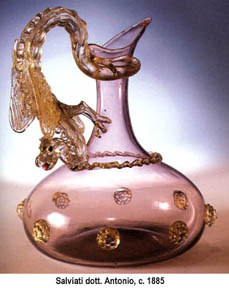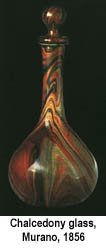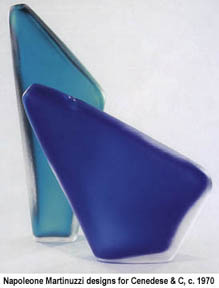History
of Murano Glass
Its birth, rise to prominence,
decline
--and magnificent revival
 Murano
Redux.
Murano is a small group of islands lying on the edge of the Adriatic
Sea in the lagoon of Venice,
about 3,000 meters north of the larger group of islands comprising
the city of Venice.
Murano
Redux.
Murano is a small group of islands lying on the edge of the Adriatic
Sea in the lagoon of Venice,
about 3,000 meters north of the larger group of islands comprising
the city of Venice.
In
the 100 years between 1860 and 1960 the glass producing firms located
on Murano rose to world leadership in the production of decorative
glass objects. One of the most remarkable aspects of this remarkable
achievement is that it was the second time that Murano had attained
that pinnacle--and the two occasions were separated by 500 years.
Early
triumph. Glassmaking existed in the lagoon of Venice from as early
as the 8th century. In ensuing centuries the artisans of Venice began
to accumulate some singular skills in glass production--gathered presumably
in the course of the Republic of Venice's extensive trade throughout
the Eastern Mediterranean and in the Islamic territories of the Levant
and North Africa. In this connection, the conquest of Constantinople
in 1204 by the wayward Fourth Crusade was
a watershed event, opening to Venice the practices of the glass producers
of that great imperial city.
By
1291 the glassmakers of the Venetian lagoon had distilled all of that
knowledge into unique and proprietary production skills. In that year
the government of Venice banned glass furnaces from the central islands
of Venice, relegating them to Murano. Most historians have assumed
that the order resulted from a fear that the fires of the glass furnaces
might create a tragic conflagration among the largely wooden structures
of crowded Venice. However, it has been plausibly suggested that the
move was made in order to isolate the master glassblowers and prevent
their sharing their valuable glassmaking knowhow with foreigners.
In fact, the glassblowers became virtual prisoners on Murano, insulated
from any contacts who might divulge their production secrets to potential
competitors abroad. Venetian--or Murano--glassmaking became the leading
source for fine glass in Europe and a major source of trading income
for the Republic of Venice.
Most
of the glass of that period, though luxurious, was utilitarian. Mirrors,
for example, were major revenue producers, but beautiful and intricate
decorative objects were produced as well, often exhibiting complex
new techniques developed by Murano's extraordinary artisans.
Slow
secular decline. Yet trade domination built on monopoly--especially
a monopoly in knowhow--is inherently unstable. By the 1600s important
rival centers had begun to emerge, notably in France and Moravia.
At the same time, shifting trade routes began to undermine Venice's
strategic trading advantages. As a result, the decline in Venice's
general political and commercial importance after 1600 was mirrored
by the gradual, long-term decline of its glass industry on Murano.
Final collapse for both the republic and the industry came with the
conquest of Venice by Napoleone's French
forces in 1797, followed in 1814 by the ultimate transfer of Venice
from France to the Habsburg Empire centered in Austria.
Death
by regulation. Austrian sovereignty brought swift regulatory strangulation
to Murano, as the Habsburg government overtly favored the other glassmaking
center within its Empire, Bohemia. The import into Murano of the requisite
raw materials was severely restricted or punitively taxed. As a result,
the number of active glass furnaces on Murano plunged from 24 in 1800
to 13 just 20 years later. Even more telling, only five of those 13
factories produced blown glass; at the others, production was reduced
primarily to decorative beads and other small items that the Empire
needed for trade abroad.
A
gloomy realist might have predicted that the last furnace fire on
Murano would soon be extinguished. Such a prediction, however, would
have overlooked the fierce, centuries-old creative heritage of the
traditional glassblowing families of Murano. They kept alive--or periodically
rediscovered--the remarkable old techniques that had reached full
flower in the 1400s, even though the new economic and political realities
had virtually eliminated all demand for the elaborate and costly products
that those skills could create.
New
life. Like twin robins of spring, two events of the 1850s herealded
a new and better period ahead. The earlier in time was the founding
in 1854 of a promising new glass furnace on Murano by six enterprising
sons of Pietro Toso. Their new firm, Fratelli Toso, concentrated
initially on producing utilitarian glass, but they soon showed that
they had grander ambitions and skills.
The
second notable event came in 1859 when an industrious lawyer from
Vicenza, Antonio Salviati, arrived on Murano with a vision of a new
market niche. His new firm Salviati dott. Antonio fu Bartolomeo
focused on producing glass tiles for repairing the ubiquitous old
mosaics of Venice and creating new ones. Fortuitously, the master
glassblowers that he assembled for the new business included Lorenzo
Radi, who had devoted considerable efforts in the 1850s to resurrecting
some of the sophisticated glassmaking techniques from Murano's first
heyday in the 1400s.
 Salviati's
mosaic glass production met with the success that he had anticipated,
but his greatest innovation lay in the insights that he brought for
marketing Murano glassware through new distribution channels. His
first success came in England in 1862 when the firm captured international
attention with its prize-winning display at a world exhibition in
London. Salviati boldly used the occasion to present products in chalcedony
glass, a medium that Radi had revived in 1856. Salviati followed up
on that first success by opening a London sales office in 1868.
Salviati's
mosaic glass production met with the success that he had anticipated,
but his greatest innovation lay in the insights that he brought for
marketing Murano glassware through new distribution channels. His
first success came in England in 1862 when the firm captured international
attention with its prize-winning display at a world exhibition in
London. Salviati boldly used the occasion to present products in chalcedony
glass, a medium that Radi had revived in 1856. Salviati followed up
on that first success by opening a London sales office in 1868.
At
last the Murano glassblowers had found the salesman they needed for
exploiting their skills throughout the broad markets beyond Italy
and the Habsburg Empire. The political winds were shifting as well,
as the Veneto was wrested free of the Austrians in 1866 to become
part of the expanded Kingdom of Italy. The new sovereign brought his
own difficult taxes, but the business climate improved and the glass
producers of Murano began to flourish again, led first by Salviati
and Fratelli Toso, and soon by other innovative firms such as Fratelli
Barovier and Francesco Ferro & Figlio.
Modern
leadership. For the most part, the designs of the new and revitalized
firms relied heavily upon their traditional Murano skills at creating
intricate curlicue fantasies in glass, though influenced by the art
nouveau movement near the end of the century. Designs were usually
the invention of the glassblowers themselves. Many of their works
were exhuberant masterpieces, but the glassblowers were ultimately
constrained by the fact that they worked within an artisan tradition,
not an artistic one.
New
forces were at work, however, beginning to open Murano to changes
stirring in the international art world. The first Venice Biennale
was staged in 1895, bringing to Venice avant garde and innovative
art from throughout Europe and challenging Murano glassmakers to stretch
as well. Artists of Venice and Murano assembled in informal groups
to exchange and espouse new artistic ideas. One such group, associated
with Cà
Pesaro and the Bevilacqua La Masa Foundation, included a number of
artists who would bring new design ideas to the Murano glassmakers.
Prominent among them Vittorio Zecchin, Napoleone Martinuzzi and, briefly
but most importantly, Hans Stoltenberg-Lerche and Teodoro Wolf-Ferrari.
 In
1921 there arrived the final element needed to propel Murano once
again into world leadership in its field. From Milan came Giacomo
Cappellin and Paolo Venini to found their own new glassworks, Vetri
Soffiati Muranesi Cappellin, Venini & C., with a particular
focus on modern design. Many of their key early designers were actually
themselves from Murano, but they were selected and supervised by the
new owners with a distinct sensitivity to the new design trends that
were sweeping the world and were so fiercely felt and debated at Milan.
Venini was a native of the Milan area; Cappellin, though a Venetian
by birth, owned and operated an antique shop on Milan's via Montenapoleone.
The new creative spark ignited by Cappellin and Venini quickly swept
Murano. The competitive spirit of the glassmakers soon catapulted
numerous Murano producers to the cutting edge of artistic design and
artisan skill that continues to characterize Murano glass down to
the present day.
In
1921 there arrived the final element needed to propel Murano once
again into world leadership in its field. From Milan came Giacomo
Cappellin and Paolo Venini to found their own new glassworks, Vetri
Soffiati Muranesi Cappellin, Venini & C., with a particular
focus on modern design. Many of their key early designers were actually
themselves from Murano, but they were selected and supervised by the
new owners with a distinct sensitivity to the new design trends that
were sweeping the world and were so fiercely felt and debated at Milan.
Venini was a native of the Milan area; Cappellin, though a Venetian
by birth, owned and operated an antique shop on Milan's via Montenapoleone.
The new creative spark ignited by Cappellin and Venini quickly swept
Murano. The competitive spirit of the glassmakers soon catapulted
numerous Murano producers to the cutting edge of artistic design and
artisan skill that continues to characterize Murano glass down to
the present day.






